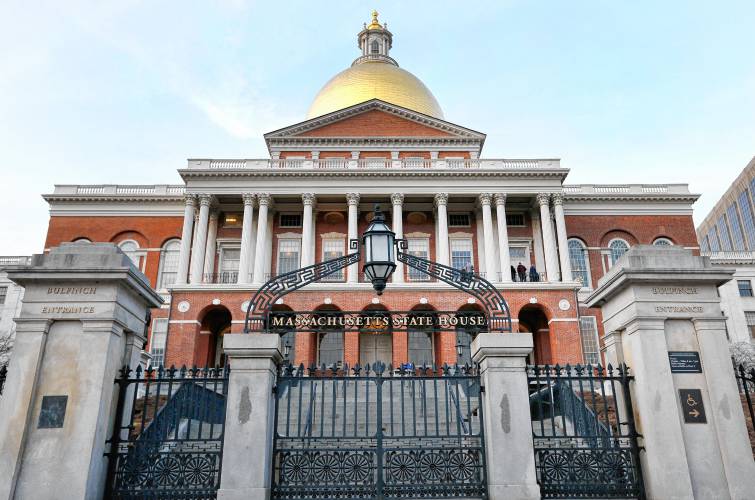Advocates in Massachusetts seek criminal justice reform despite federal uncertainty

The Massachusetts State House AP FILE PHOTO/ELISE AMENDOLA
| Published: 05-31-2025 8:57 PM |
With unpredictability surrounding federal funding and the tough on crime rhetoric under President Donald Trump’s administration, Massachusetts advocates are pushing for alternatives that seek rehabilitation rather than punishment for criminal offenders.
Restorative justice is a community-based approach that addresses harm through facilitated dialogue.
The approach originated from Indigenous groups. Now, many of the environments that initiatives reach are “communities that are marginalized,” said William Rodriguez, professor of youth justice and advocacy at Boston University.
“Restorative justice is a philosophy,” Rodriguez said. “It’s really about healing, and in some ways, it’s harm reduction.”
The practice involves a wide range of approaches including victim-offender dialogue, conferencing, peacemaking circles, reparative boards, restitution, community service and reintegration services.
Currently in Massachusetts, there are over 20 community-based restorative justice programs. Projects are managed through both government and non-profit sectors including police departments, law offices, schools, community mediation centers and the courts.
These programs work on a range of topics including youth and gang violence, juvenile and adult diversion, reentry and housing instability.
Reps. Simon Cataldo, D-Concord and Sean Garballey, D-Arlington, have proposed a bill that would establish an Office for Restorative Justice in the Commonwealth.
Article continues after...
Yesterday's Most Read Articles
Cataldo said the initiative intends to build off the criminal justice reform laws passed in 2018 under Gov. Charlie Baker’s administration. The act created a Restorative Justice Advisory Committee, composed of members of law enforcement, judiciary representatives, legislators and advocates.
“Last year, the committee itself decided to propose the creation of the state’s first Office of Restorative Justice,” Cataldo said. “That office is what’s reflected in the legislation.”
The 2018 act also aimed to lower recidivism rates by increasing rehabilitative programming and offering the possibility of sentence length reduction for good behavior. Additionally, it increased the age of juvenile court jurisdiction, so children under 12 can no longer be arrested, prosecuted or confined.
Rep. Christopher Worrell, D-Boston, has also proposed a bill to combat mass incarceration in the commonwealth. If passed, each individual would be given the opportunity to participate in a restorative justice program through the Massachusetts Department of Correction.
The bill also proposes granting incarcerated individuals a parole hearing after serving 25 years of their sentence, regardless of the terms of their initial sentencing.
At a more local level, Newton District Court Judge Mary Beth Heffernan said she uses mediation in many civil practices, along with community service, to resolve cases.
She said practices like these are helpful in situations between landlords and tenants or people who are “pro se” or representing themselves in court.
Heffernan also said community service through the probation department allows for cleaner streets and city parks as an alternative to paying fines or legal fees.
Despite initiatives for restorative justice arising in states like the commonwealth, the United States currently hosts the largest number of prisoners worldwide, with more than 1.8 million incarcerated at the beginning of the year, according to Statista.
“We’re very punitive. We’ve got the most people in jail,” said Rodriguez.
Rodriguez said that the “tough on crime” rhetoric common in the 1980s reflected the political climate at the time. In that era, schools embraced punitive disciplinary actions such as suspension and expulsion, as well as zero-tolerance policies.
Now, Rodriguez said, attitudes across the country are similar under Trump’s leadership.
Last month, in a series of executive actions, the Trump administration ordered the Department of Education to cease efforts ensuring equity in school discipline. This is a reversal from the previous administration’s efforts to reduce the disproportionate punishment of students of color.
In a January executive order, the administration referred to those “Equity Action Plans” as an “immense public waste and shameful discrimination.”
Four months later, the White House issued another executive order, stating its goals to “aggressively police communities against all crimes” instead of pursuing “equity policies.”
At the same time, the Department of Justice is terminating $811 million in grants, with the cuts impacting victim services programs ranging from trauma centers to police training, according to Reuters.
Regardless of federal involvement, Cataldo said the Office for Restorative Justice could save the commonwealth money if employed.
“I think that the folks who support this bill are really committed to doing criminal justice in the Massachusetts way,” Cataldo said. “That’s led to stark reductions, both in the prison population and also in recidivism rates over the last 10-plus years.”
A study shows that after the 2018 reform, white incarceration rates in Massachusetts saw the most change — declining 40% from 2017 to 2021. However, racial disparities widened due to the rapid change in white imprisonment rates, according to a GBH analysis.
Since 2020, the incarceration rate for the Latino population has been rising, while the Black population in Massachusetts is over seven times more likely to be incarcerated than their white counterparts.
Additionally, Black and Latino youth are more likely to be exposed to schools with punitive disciplinary structures that funnel students into the justice system, according to a 2022 study.
“The fundamental part of this country is liberty,” Rodriguez said. “And yet we deprive liberty of everyone that we funnel through the system.”
When the criminal justice system punishes people who’ve caused harm, it leads to “more harm happening,” said Ren Liu, communications and outreach manager for Jane Doe Inc., a Boston-based domestic violence advocacy organization.
“That doesn’t stop the cycle of violence that happens or create conditions to stop why harm happened in the first place,” Liu said.
However, some professionals critique the restorative justice approach, including Mikhail Lyubansky, a psychology professor at the University of Illinois, Urbana-Champaign.
Lyubansky said in some instances the approach would not work. For example, if the mediator sees the approach as an opportunity to control behavior — especially in a school setting — he would expect the students to resent and resist the attempts.
Currently, under the system, Liu said survivors might find safety within the existing punitive systems because it creates distance and boundaries between them and those who have harmed them.
However, with some restorative justice practices, Liu said survivors can create the needed boundaries without “inhumanely locking someone up.”
When survivors are centered in the process, they can dictate their agency and what kind of relationship they want to have with the person who harmed them, Liu continued.
Cataldo said the victim-centered nature of the restorative approach is a more holistic way of handling criminal matters.
However, when using a restorative approach, Heffernan said every party involved must understand and agree with the appropriate resolutions for the case.
“I think you have to be very, very careful about what people’s expectations are,” Heffernan said.
Rodriguez also added for these programs to work, vulnerability is necessary, along with acknowledgment of limitations and challenges.
“Sometimes to put them with the person who’s been victimized by them is really profound and impactful,” Rodriguez said.
Payton Renegar writes for the Recorder from the Boston University Statehouse Program.






 South County Notebook: Aug 17, 2025
South County Notebook: Aug 17, 2025 Mohawk Trail students to see new staff, new codes of conduct upon Aug. 27 return to school
Mohawk Trail students to see new staff, new codes of conduct upon Aug. 27 return to school Grand opening of Buckland-Shelburne Elementary School playground set for Aug. 26
Grand opening of Buckland-Shelburne Elementary School playground set for Aug. 26 Bear-y unwelcome: Why MassWildlife says it’s time to ‘break up’ with bird feeders
Bear-y unwelcome: Why MassWildlife says it’s time to ‘break up’ with bird feeders
